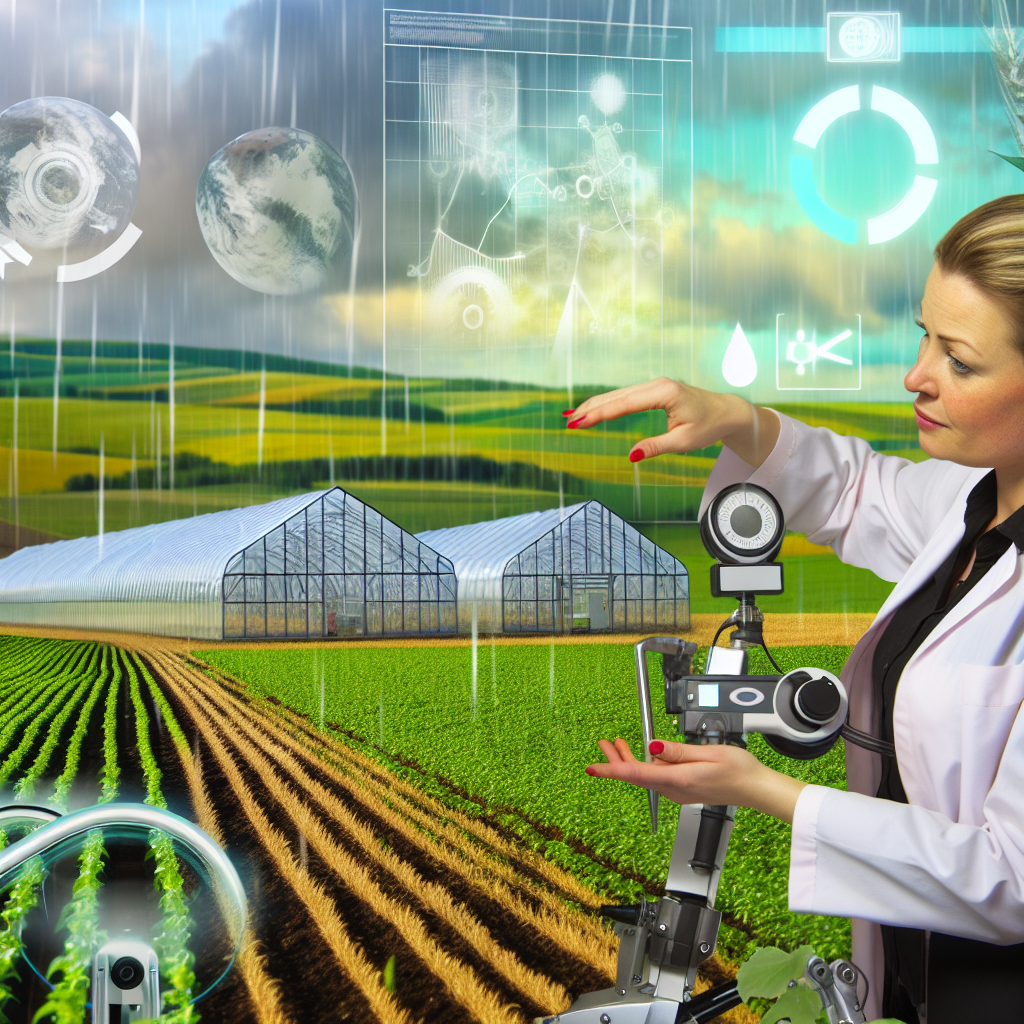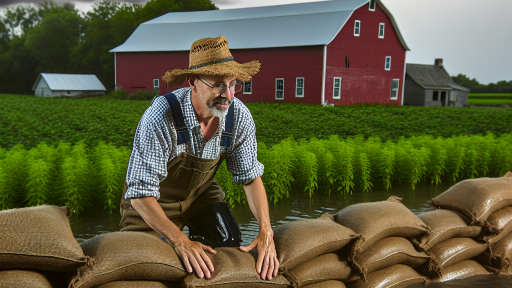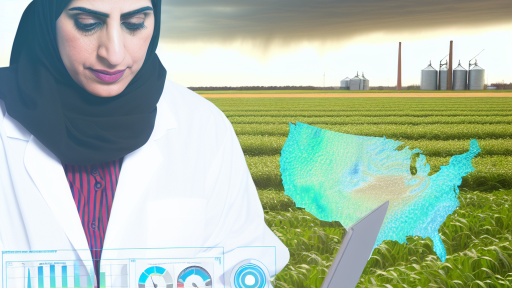Understanding Climate Change: Impact on Global Agriculture
Definition and Causes of Climate Change
Climate change refers to long-term changes in temperature and weather patterns.
Human activities significantly contribute to these changes.
Burning fossil fuels increases greenhouse gases in the atmosphere.
Deforestation also plays a crucial role in altering local and global climates.
Effects of Climate Change on Agriculture
Agriculture faces numerous challenges due to climate change.
Temperature increases can lead to reduced crop yields.
Unpredictable weather patterns impact planting and harvesting times.
Prolonged droughts threaten water availability for irrigation.
Additionally, increased rainfall can cause flooding and soil erosion.
Regional Variations in Impact
The effects of climate change vary by region.
Tropical regions are more susceptible to extreme weather events.
In contrast, temperate zones experience shifts in growing seasons.
For instance, warmer temperatures may benefit some crops in cooler climates.
However, they can also promote pest and disease outbreaks.
Adaptation Strategies for Farmers
Farmers must adopt strategies to cope with these changes.
Transform Your Agribusiness
Unlock your farm's potential with expert advice tailored to your needs. Get actionable steps that drive real results.
Get StartedImplementing drought-resistant crops can improve food security.
Additionally, practicing crop rotation enhances soil health.
Investing in water-efficient technologies helps optimize irrigation.
Furthermore, sharing knowledge with local farming communities promotes resilience.
Identifying Vulnerable Crops
Understanding the Impact of Climate Change
Climate change poses significant challenges to agriculture.
Rising temperatures affect crop yields and quality.
Additionally, shifting precipitation patterns lead to water scarcity.
Farmers must recognize the specific crops at risk.
Assessing Crop Vulnerabilities
Evaluating each crop’s resilience is essential.
Some crops, such as wheat and corn, are particularly sensitive to heat.
Others may struggle with increased pest populations due to warmer climates.
Farmers can utilize historical data to assess risks effectively.
Adapting Strategies for Vulnerable Crops
Implementing adaptation strategies can mitigate risks.
Crop rotation enhances soil health and reduces pest buildup.
Developing drought-resistant varieties proves beneficial.
Farmers should also consider adjusting planting dates.
Research and Innovation in Agriculture
Investing in research is crucial for adaptation.
Public and private sectors should collaborate for technological advancements.
Innovations like precision agriculture enhance resource efficiency.
Furthermore, genetic modification can improve crop resilience.
Community Engagement and Education
Local farming communities play a vital role in adaptation.
Sharing knowledge helps farmers learn from each other.
Workshops can educate on best practices and new techniques.
Moreover, community resources can support vulnerable farmers.
Showcase Your Farming Business
Publish your professional farming services profile on our blog for a one-time fee of $200 and reach a dedicated audience of farmers and agribusiness owners.
Publish Your ProfileSoil Health Management
Importance of Soil Health
Soil health is crucial for sustainable agriculture.
Healthy soil enhances crop resilience to climate change.
It promotes nutrient cycling and improves water retention.
Additionally, it supports a thriving ecosystem beneath the surface.
Practices for Enhancing Soil Health
Several techniques can improve soil health effectively.
Crop rotation helps prevent soil depletion.
Diverse plantings can enhance soil structure and fertility.
Cover cropping protects soil from erosion while adding organic matter.
Furthermore, reduced tillage minimizes soil disturbance.
Organic Amendments
Using organic amendments boosts soil health significantly.
Compost enriches soil with vital nutrients.
Applying manure improves soil texture and fertility.
Furthermore, it increases microbial activity within the soil.
Soi Conservation Techniques
Implementing conservation practices safeguards soil health.
Buffer strips control runoff and reduce erosion.
Contour farming follows the land’s natural contours, reducing soil loss.
Furthermore, agroforestry integrates trees, improving biodiversity and soil stability.
Monitoring and Adaptation
Regular soil testing ensures you understand soil health dynamics.
Adjusting practices based on test results is essential.
Monitoring helps farmers respond to changing climate conditions proactively.
Adapting management strategies improves resilience against climate variability.
Community Engagement and Education
Educating farmers on soil health management is vital.
Workshops can provide hands-on experiences with best practices.
Sharing success stories fosters a supportive community.
Ultimately, collaboration promotes wider use of sustainable techniques.
See Related Content: Farming Resilience: Adaptation Strategies That Work
Water Resource Management
Innovations in Irrigation
Adapting to climate change requires innovative irrigation practices.
Traditional irrigation methods often waste water resources.
New technologies enhance efficiency and reduce waste.
Smart Irrigation Systems
Smart irrigation systems use sensors to monitor soil moisture.
This technology adjusts watering schedules automatically.
Farmers can save water while optimizing crop yield.
Drip Irrigation Techniques
Drip irrigation delivers water directly to plant roots.
This method minimizes evaporation and runoff.
It can reduce water usage by up to 50 percent.
Rainwater Harvesting
Rainwater harvesting captures runoff for irrigation use.
This sustainable method supplements traditional water sources.
Farmers can store water for dry periods effectively.
Soil Moisture Sensors
Soil moisture sensors provide real-time data on soil health.
These devices allow better water management decisions.
Showcase Your Farming Business
Publish your professional farming services profile on our blog for a one-time fee of $200 and reach a dedicated audience of farmers and agribusiness owners.
Publish Your ProfileImplementing them can significantly improve crop irrigation.
Community-Based Water Management
Collaborative efforts enhance water resource management.
Communities can share strategies and best practices.
This approach fosters sustainable developments across regions.
Education and Training
Training programs teach farmers about innovative technologies.
Knowledge-sharing leads to improved practices in agriculture.
Educated farmers can adapt more swiftly to climate impacts.
Explore Further: Creating Buffer Zones to Protect Farms from Flooding
Crop Diversification
Benefits of Using a Variety of Species
Crop diversification enhances resilience against climate change.
By planting multiple species, farmers create a buffer against pests and diseases.
Diverse crops can better adapt to changing weather patterns.
Moreover, they utilize resources more efficiently.
This leads to improved soil health over time.
Additionally, diverse cropping systems enhance biodiversity on farms.
Farmers can benefit economically from a broader range of products.
For instance, they can tap into niche markets with specialty crops.
Consequently, this practice can increase farm profitability.
Furthermore, it reduces reliance on any single crop.
This leads to lower overall risk in production.
Transitioning to diverse crops can also improve community resilience.
It fosters greater food security within local food systems.
Diversification supports sustainable agricultural practices.
Farmers who adapt will thrive in a changing environment.
Explore Further: Harnessing Solar Power for Sustainable Agriculture

Integrating Technology: Precision Agriculture and Climate Adaptation
Introduction to Precision Agriculture
Precision agriculture leverages technology to enhance farming efficiency.
This approach uses data and analytics to optimize crop production.
By monitoring environmental conditions, farmers can make informed decisions.
Benefits of Precision Agriculture
One of the primary benefits is increased yield and reduced waste.
Farmers can apply chemicals and water more accurately.
This reduces the environmental impact of farming activities.
Moreover, it leads to cost savings in inputs like fertilizers.
Technologies Driving Precision Agriculture
Several technologies contribute significantly to precision agriculture.
Drones provide aerial imagery for crop health assessments.
Additionally, sensors collect real-time data on soil moisture levels.
GPS technology helps in mapping fields accurately.
Real-World Applications
Farmers like Marco Jennings utilize precision agriculture effectively.
He employs satellite imaging to monitor crop progress weekly.
This allows for timely interventions and adjustments.
As a result, Marco can increase his yields while reducing resource waste.
Climate Adaptation through Technology
Climate change poses challenges to traditional farming practices.
Showcase Your Farming Business
Publish your professional farming services profile on our blog for a one-time fee of $200 and reach a dedicated audience of farmers and agribusiness owners.
Publish Your ProfilePrecision agriculture aids in adapting to these climatic variations.
For instance, predictive analytics can forecast adverse weather events.
Farmers can then adjust planting schedules to mitigate risks.
Challenges and Considerations
Despite its benefits, precision agriculture has challenges.
Initial setup costs for technology can be high.
Additionally, farmers require training to effectively use these tools.
Furthermore, data privacy concerns emerge with increased monitoring.
Future of Precision Agriculture
The future of precision agriculture looks promising.
Advancements in machine learning will enhance predictive capabilities.
Moreover, ongoing innovations will simplify the use of technology.
Farmers will increasingly rely on tech-driven solutions for sustainability.
Uncover the Details: Protecting Crops: Best Water Management Practices
Policy Frameworks
Role of Governments
Governments play a crucial role in adapting agriculture to climate change.
They develop frameworks that support adaptive practices and sustainable techniques.
These frameworks involve legislation and policy that prioritize environmental resilience.
Government incentives can encourage farmers to adopt best practices for sustainability.
Financial Support Programs
Financial assistance programs are vital for farmers in transition.
Subsidies can lower the cost of adopting new technologies.
Grants may support research into climate-resilient crops.
Furthermore, loans can help farmers invest in adaptive infrastructure.
Education and Training Initiatives
Education programs equip farmers with knowledge and skills.
Training initiatives focus on climate-smart agriculture practices.
Workshops can foster community engagement and information sharing.
Moreover, extension services provide direct support to individual farmers.
Collaboration with Research Institutions
Collaboration with research institutions enhances adaptive farming techniques.
Governments can partner with universities for innovative agricultural research.
This cooperation drives the development of climate-resilient crop varieties.
Additionally, it promotes the best practices based on scientific evidence.
Public Awareness Campaigns
Public awareness campaigns inform citizens about climate change impacts.
These campaigns highlight the importance of sustainable agriculture.
Furthermore, they can mobilize community support for adaptive policies.
By raising awareness, governments foster a culture of environmental stewardship.
Community Engagement: Involving Farmers in Developing Solutions
Importance of Farmer Participation
Engaging farmers in climate change solutions proves essential.
They possess invaluable local knowledge and experience.
This insight aids in creating effective, context-specific strategies.
Building Collaborative Platforms
Establishing community forums encourages open dialogue among farmers.
These forums provide spaces to share challenges and innovations.
Furthermore, they foster collective problem-solving approaches.
Training and Resources
Offering training programs helps farmers adapt their practices.
These programs focus on sustainable farming techniques.
Showcase Your Farming Business
Publish your professional farming services profile on our blog for a one-time fee of $200 and reach a dedicated audience of farmers and agribusiness owners.
Publish Your ProfileAccess to resources enables farmers to implement effective solutions.
Utilizing Technology for Engagement
Modern technology enhances communication between farmers and experts.
Mobile applications can facilitate real-time information sharing.
Thus, farmers can access critical data for decision-making.
Incorporating Feedback for Continuous Improvement
Feedback mechanisms ensure solutions evolve based on farmer input.
These systems encourage farmers to share their successes and challenges.
Consequently, this leads to better strategies tailored to local needs.
Success Stories from the Community
Showcasing successful adaptations inspires other farmers.
For example, local co-operatives have implemented new irrigation methods.
These methods have significantly reduced water usage.
Creating Support Networks
Establishing peer networks promotes knowledge sharing among farmers.
In these networks, farmers can learn from each other’s experiences.
Consequently, collaboration strengthens agricultural resilience.
Additional Resources
Climate change and adaptation in agriculture: Evidence from US …




